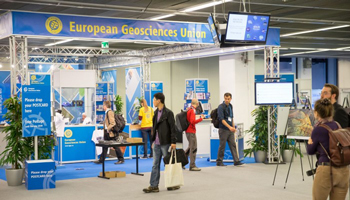Investigación del profesor Marcelo Lagos se expone en la Conferencia de la “European Geosciences Union”

Entre los días 12 al 17 de abril se realizó en Viena, Austria, la "European Geosciences Union Media at General Assembly 2015 (EGU 2015)", que reunió a unos 12.000 científicos de todo el mundo, en un encuentro que abarca todas las disciplinas de las ciencias de la Tierra, planetarias y espaciales. El encuentro ofrece una oportunidad de aprender sobre los nuevos avances de la ciencia en una variedad de temas, incluyendo el cambio climático, las misiones científicas planetarias, los desastres naturales, la acidificación de los océanos, la pérdida de los hielos eternos y el aumento del nivel del mar, entre otras importantes temáticas.
El profesor Lagos, en conjunto con Hermann M. Fritz, del Georgia Institute of Technology, Civil and Environmental Engineering (Atlanta, EE.UU.), presentaron el trabajo "One year after the 1 April 2014 Iquique tsunami field survey along the coasts of Chile and Peru", que es parte de una investigación sobre el terremoto y tsunami de 2014 en el norte de Chile.
El trabajo destaca que el evento en el norte de Chile, plantea retos importantes especialmente en la educación de la comunidad y su sensibilización para efrentar el riesgo de tsunami. Estos programas de sensibilización, son esenciales para salvar vidas en lugares con riesgos latentes de tsunamis.
La investigación que desarrolla el profesor Marcelo Lagos y su equipo, utiliza metodologías cientificas, propias de las ciencias de la tierra, y también metodología cuantitativa de encuestas a los residentes.
ABSTRACT
One year ago on the evening of 1 April, 2014 a magnitude Mw 8.2 earthquake occurred off the coast of northern Chile off the coast of Pisagua within a region of historic quiescence termed the northern Chile seismic gap. The ensuing tsunami inundation caused mostly minor damage centered in Iquique and neighbouring stretches of coast- line. Fortunately, ancestral knowledge from the past 1868 and 1877 tsunamis in the region along with the recent 2010 Maule tsunami, as well as tsunami education and evacuation exercises prompted most coastal residents to spontaneously evacuate to high ground after the earthquake. There were no tsunami victims; while a handful of fatalities were associated to earthquake induced building collapses and the physical stress of tsunami evacuation. The Arica native local scientist deployed overnight and started the tsunami survey in Iquique on the day after the earthquake. The international scientist joined the local effort from April 6 to 11, 2014. The international tsunami survey team (ITST) interviewed numerous eyewitnesses and documented flow depths, runup heights, inundation distances, sediment deposition, damage patterns, performance of the navigation infrastructure and impact on the natural environment. The ITST covered a 700 km stretch of coastline from the Mejillones Peninsula (23.5◦ S) north of Antofagasta in Chile up to Vila Vila (18.1◦ S) in southern Peru. We surveyed 30 locations with differ- ential GPS and laser range finders. The tsunami impact peaked at Caleta Camarones exceeding 5 m in tsunami runup height. A significant variation in tsunami impact was observed along the coastlines of Chile and Peru both at local and regional scales. The tsunami occurred in the evening hours limiting the availability of eyewitness video footages. Observations from the 2014 Chile tsunami are compared against the 1868, 1877 and 2010 Chile tsunamis. Comparing to other similar magnitude events such as the 2007 Pisco tsunami in Peru the 1 April 2014 tsunami could have been significantly larger. The absence of a massive tsunami may mislead residents to believe another similarly minor tsunami may be generated after a potential future earthquake of similar magnitude. This April fool’s day event poses significant challenges to community-based education raising tsunami awareness. The team educated residents about tsunami hazards since awareness programs are essential to save lives in locales at risk from near-field tsunamis.




